Editor's note: This is an edited transcript of the live expert e-seminar presented on October 29, 2010. To view the Recorded Course, click here.
Introduction
In these busy times, there is a real need to prioritize and plan in our practices. Today we'll put on our audiology and business caps and discuss ways we can cut through the clutter and chaos of life to prioritize our businesses. Secondly, we'll talk about some tools that can help to increase the overall productivity of a practice, as well as how to provide a more engaging, memorable experience for the customer.
To give you some background information, I pulled up some interesting statistics from the Internet. Americans spend almost 14 billion minutes a year on Facebook. MySpace comes in a close second at 5 billion minutes. Worldwide we know there are approximately 17 billion devices connected to the Internet - this would include computers, smart phones, iPads, etc. eBay processes $680 worth of transactions every second. While we are more connected through technology today, we are also living further and further way from our jobs. The average daily commute is almost 50 minutes. The average entrepreneur with their own business works almost 60 hours a week. When we consider our lifestyle, our time at work and away from work, our time spent staying "connected" through technology, we easily see how busy we are and why the need to prioritize and plan is more important today than it was even a couple of years ago.
If you are in practice for yourself or you manage an audiology practice, you probably spent a good deal of your professional education learning about audiology diagnosis and management including fitting hearing aids. However, equally important to your practice are issues such as recruiting, hiring and training staff, payroll, cost of goods, marketing, and cash flow, just to name a few. It is very easy to get overwhelmed when you have a busy and overscheduled practice. Your long term success will depend on your ability to cut through the clutter and prioritize.
Cutting Through the Clutter
To successfully trim the excess and make room for productivity, it is imperative to identify the six mistakes that overcomplicate things and slow productivity in business. There are questions to ask that will help you self-identify weaknesses and get back on the right track.
Big Mistake No. 1: Trying to be all things to all people
This means that you're not only trying to offer your services and products at a reasonable price, but you also have multiple product offerings at several price points or technology tiers. If you're juggling numerous price points, you're likely juggling numerous manufacturers and software modules, and trying to be an expert in them all. You may be trying to offer services above and beyond fitting hearing aids and diagnostic testing. Maybe you want to offer pediatric specialties, open a tinnitus center, or get into vestibular testing. The list can go on from there. On top of it all, you want to provide an outstanding quality of care. You want to have long hours, maybe evening or Saturday office hours, and maybe even have a medical or retail focus.
While these are admirable objectives, realistically you need to evaluate if your business has the capacity to take on all these areas. It is necessary to focus on what your sweet spot might be according to where the marketplace dictates, as well as what you might be passionate about providing.
To get on the right path in this situation ask yourself, "What do I want my practice to be known for?" In other words, what do you want your legacy to be?
No matter what business you are in, there are five possible areas in which your business can be a leader: Low Prices; convenience; technology; customer service; and providing a memorable experience.
This idea comes from one of the leading business schools. Let's take the first area - being the low-cost leader. In this case, you may want to purposefully brand your business as a low-cost leader in the same way Wal-Mart has. In our industry, you could offer the lowest prices and market yourself to that strength.
Alternately, you could have the most convenient office. This could entail special office hours, location, or a point of contact so that when someone calls your office they get an appointment right away. Those are all facets of the convenience. There are businesses throughout the country that are known for being incredibly convenient and easy to work with.
A third is to offer the best, cutting-edge technology. In our business that would mean hearing aid technology or even office equipment and accessories. There is no manufacturer in the industry right now that can differentiate itself based on technology alone. There is no consensus as to who is the clear leader.
You could also differentiate your practice based on the level of customer service that you provide, which is the way you deliver the hearing aids, the way you answer the phone, the way you speak with your customers when they have complaints, or the little perks that go along with your service. That is, in the end, what providing a memorable experience is about.
An experience is something that is emotionally engaging. A service is something that you deliver, but an experience is something that patients remember. In order for your business to stand out, eliminate the gray area that exists between customer service and providing a memorable experience.
When you ask the question, "What do I want my practice to be known for," consider the given answers and pick two of the five areas and build your process and your plans around those areas. While many people in our field choose to focus on customer service and providing a memorable experience, there is no right or wrong choice. Make a commitment, and be vigilant in focusing your efforts and marketing on those areas.
Big Mistake No. 2: Failing to be memorable to the customer
Even though you may have decided that you would like to create a memorable experience, many businesses make the mistake of actually failing to provide just that! When you fail to be memorable to the customer, you are indirectly losing potential referrals. Ours is a small industry, and much of our business comes from referrals. Word-of-mouth is absolutely critical to the success of our business. The more memorable we can be in the way we deliver services, the more word-of-mouth referrals we will create, and the more successful our business will be.
In order to be memorable to our customers, think of breaking down the customer's experience to every point of contact or interaction. Consider how each point of contact can be more emotionally appealing, more engaging, and more memorable with the intent of creating more satisfied customers who will in turn generate more word-of-mouth referrals. Put yourself in your customers' shoes and ask yourself, "If I were coming here, what would make this experience memorable to me?"
There is an interesting concept that comes from business leaders at the Harvard School of Business who have authored a book on the idea of creating value in an office. The book is entitled The Value Profit Chain (Heskett, et al., 2003) and it provides a very eloquent equation:
Results + Process Quality divided by
Price + Convenience Costs = VALUE
This means that Results, or what you have done to try to fix someone's problem, plus the Process Quality, or the quality of the way you engage the patient, summed together must exceed the two variables of retail Price and the Convenience Costs in order to create Value. Convenience costs are things like the accessibility of the office; Was it easy to park?; Did they give me the runaround when I tried to call on telephone?; Are they a hassle to work with because they're not open very often or they're not easy to get in to see? The variables on the top of the equation indicate direct results, measurable success, and perceived patient benefit. These things have to exceed the total costs for the patient in order to experience value.
Value is bang for the buck. Value means it is worth my time, energy and money to work with this business because they solved my problem and they're kind of fun to work with. That is the value equation, and I think it has a lot of utility in our profession.
Heskett and colleagues (2003) also look at the value equation in action in terms of customers' level of satisfaction as compared to their loyalty. Patients who fall low on the satisfaction scale and low on the loyalty scale are referred to as Antagonists. When they looked across dozens of service industries, on average about 4% of all customers would be considered Antagonists. These are the people who are extremely unhappy and tell other people about the terrible experience they may have had in an office.
On the other hand, almost three out of every four customers (72%) are what they refer to as Mercenaries. Mercenaries are customers in the middle of the scale when it comes to satisfaction and who are not very loyal. As the name implies, as soon as they see a better offer or a more appealing ad in the paper, Mercenaries will flee your office and purchase hearing aids elsewhere. These people may be very driven by price.
Then there are Loyalists, who make up 12% of total customers. These are patients who are generally happy. They are more satisfied than Mercenaries, but their loyalty levels are only slightly better. They are referred to as passively satisfied because, in general, they are not all that loyal. Next are the Viral Loyalists, who have high levels of satisfaction and might talk a little bit about you and the quality of your services and products to their friends and families.
Apostles have high levels of satisfaction and who are highly loyal. These are the customers who refer two or three patients a year to our office. They have influence in the community, as they have a strong social network and are almost like your unpaid marketing force. Overall, the more satisfied you can make someone, the more likely they are to refer others to your office. In our industry, that is absolutely critical for business success.
The last category is Hostage. A Hostage is someone who is going to do business with you for contractual reasons; for example, they may have a medical benefit where they can only receive services from your particular office. They are loyal, but they may or may not be highly satisfied. This may be not as common in our industry as in some of the other medical professions.
The bottom line is to be memorable to your customers in a way that creates lasting value. Avoid the modernization trap, and answer the value question for yourself in terms that are meaningful to you.
Progression of Economic Value
The term progression of economic value is taken from a fantastic book called The Experience Economy, which was published in 1999 by Pine and Gilmore. This construct says that if you look back 50 or 100 years ago, we had a very agrarian economy, with the majority of people working and living on farms. This was a do-it-yourself lifestyle where people extracted things directly from the earth, and they made goods for everyday use themselves. Subsequently, it was a culture that thrived on very little and learned to do without excess.
Then we fast-forward and look at 30 or 50 years ago during the height of the industrial revolution with automobiles, mass made clothing and other items you find in a service economy. Manufactured goods became cheaper, along with the labor required to produce them. Things made overseas and shipped here cost less than making them ourselves. Our economy shifted to more of a service economy where we delivered goods. This can be thought of in terms of restaurants, for example, where services were delivered, and more people entertained employment in those types of jobs.
Now that services have become kind of a commodity, the next level is to make an Experience Economy. Places like Chuck E. Cheese or American Girl, really any themed restaurant or shopping center, or ballparks where much of the grandeur is a culmination of staged experiences, are all business that revolve and thrive around the experiences that are provided to the customer. Shareef Mahdavi is an expert in the Experience Economy especially as it relates to healthcare (www.sm2strategic.com).
Pine and Gilmore (2003) provided the following example of the progression of economic value. Coffee beans are grown in warm weather places and then shipped to ports all around the United States. Those coffee beans are really only worth the penny when you physically grind them up and make a cup or two of coffee, which can be time consuming when you choose to do it yourself. But when you ship those coffee beans to a place like Maxwell House, they are able to grind mass quantities, package them in a can, and give easier access through a grocery store. When you buy the can from the store, those two cups of brewed coffee may be worth a few pennies more when you brew it at home due to the convenience of the product.
Then we take this to the next level and offer the same product on a service level. You can go into a restaurant and buy the cup of coffee ready for consumption for $1 or $2. Over the last 10 years or so, places like Starbucks and Caribou Coffee double the value to 3, 4, or $5. You still get the $2 cup of coffee but there is an entire experience wrapped around it. I think this same kind of example can apply to the way we deliver hearing aids.
To help elicit this point in terms familiar to audiology, I'm going to walk you through an exercise I call process mapping (Figure 1). The point of the exercise is to start thinking about how you interact directly and indirectly to create certain experiences along a continuum with a patient.
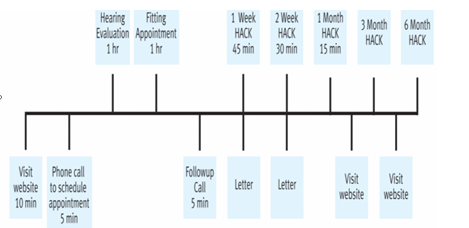
Figure 1. Example of process mapping.
You can think of what you see in Figure 1 as a time line that covers the course of one to two years. The Web site visit is the first time the patient has thought about amplification or the possibility of having a hearing loss, and they're doing some checking around to investigate their options. At the very end of the timeline we find a loyal and satisfied customer. The idea behind the timeline is to contemplate how you to handle the separate "touch points" where the patient makes contact with your business face-to-face in your office. Because there are many opportunities for direct interaction with the patient, one of the questions you want to ask yourself is, "What is the optimal amount of time that I want to spend at each one of those face-to-face interactions with the patient?"
An interesting and effective way to approach the touch points is to think about all the negative cues that would potentially turn people off to your business. An example of a negative cue might be when someone calls your office to make an appointment and has a bad experience. If they don't have their questions answered very effectively, if the receptionist is chewing gum, or if the phone rings several times before answering and then they were immediately put on hold, the customer perceives these as negative cues. You want to avoid negative cues at all possible costs.
One proactive approach to negative cues is to go through each of the rooms in your office and look for them. Look for sights and sounds that could be potential negative cues like a stain on the ceiling or a squeaky air conditioning vent, for example. Believe it or not, when you start examining every touch point or interaction station you may uncover things that turn patients off or that do not contribute to a positive experience.
Some excellent information on creating a memorable patient experience came from a consumer survey by Hearing Industries Association and was presented earlier this year (2010) by Carole Rogin. She entitled the presentation Top Ten Reasons for Hearing Aid Delight. Three actionable best practices came out of that survey that can contribute to a more memorable experience for your patients: Spend more time with your patients doing high tech/high-touch testing; have an impeccably clean office; and measure the results of the fitting and share the information with your patients in a way that is meaningful to them. That means using questionnaires and self reports rather than showing them objective diagnostic information that may not be meaningful to them. A fourth recommendation is to encourage a companion to attend appointments with the patient.
Big Mistake No. 3: Focusing exclusively on business results, namely profit and revenue.
If your business is not profitable you will not to be able to keep your doors open very long. Results are important, but there are a lot of indirect ways we can focus on profit and revenue that can have a positive impact on our business.
We can look at competitive sports such as NASCAR as an example of how to do this. The NASCAR champion envelops more than just having the fastest car. There are a team of people that work under the hood and engineer the car. Others make sure the tires and the engine are at their peak efficiency. The entire team has to work from the ground up to achieve results. It is the same for any audiology or business practice - you have to build a team from the ground up and focus on people and processes.
The question you have to ask yourself is, "What actions do I have to take to achieve profitability and revenue standards that are right for me?" You must consider the actions or behaviors that you engage in on a daily basis that are important. One way to do that is to boil it down to the essence of profitability and productivity. Look at three key revenue drivers: office traffic, the number of units that you sell, and the average selling price. Carefully allocate resources, time, money and effort and have a plan for all three of these key drivers.
The path to double digit growth in a practice is by having an obsession about how you can grow and improve in those three areas. One way you can do that is by walking the four walls of your practice: Financials, People, Sales and Marketing, and Processes. Financials refers to profitability, holding expenses in line, gross revenues, gross profits, etc. The second wall of your business would be the people that are inside of it. Are they properly trained? Are they motivated? Are they doing all the things that they need to do to maximize patient satisfaction? Then we have sales and marketing. What are you doing to drive people in your door? What are you doing to get people to come back? What are you doing to get people to want to do business with you when it comes to the point of sale? Those are all absolutely critical behaviors that need to be measured. Next we have processes, or what actually happens moment to moment with every patient, in every interaction in your office. As a reference, an article published by Kaplan and Norton (1992) outlines how to measure these four walls in your practice.
Big Mistake No. 4: Failure to identify the strengths and weaknesses of your business.
The fourth mistake is crucial, and that is, the failure to identify the strengths and weakness of your business. Let's say that you have already decided what you're all about; you are confident in what your office is known for and you have a concrete goal in mind for that area. It is easy then to haphazardly plan, or to fall short on strategy unless you critically examine the strengths of your office, the areas that need improvement, the opportunities, and the threats to your business.
Two very specific questions that can hone in on solutions to these problems are:
"How do I better understand my strengths and my limitations," and "What opportunities do I have to improve?"
One very effective visual tool you can use to do this (Figure 2) is called SWOT: strengths, weaknesses, opportunities, and threats. This is a great exercise to do with staff because it takes thoughtful brainstorming. The best way to execute a SWOT analysis is to have your team provide input from both personal perspectives as well as for the organization as a whole. Come back together and discuss what falls into each quadrant and what overlaps from everyone's point of view.
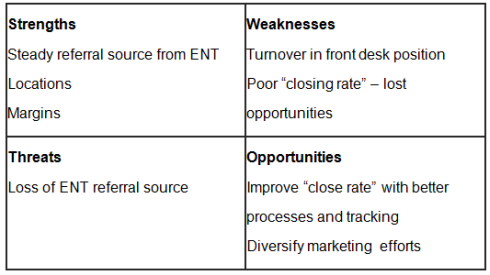
Figure 2. Example of a SWOT analysis for a sample business.
Big Mistake No. 5: Failing to have an actionable, simple strategy.
Once you have decided what you want to be known for, and performed your SWOT analysis, how do you bring your strategy to life?
Big Mistake number 5 is failing to have a simple, actionable strategy. The two key words here are simple and actionable. Your strategy should be one that anyone could execute with very little training or education from you.
At Unitron, we developed a tool called the POSI: Practice Oriented Scale of Improvement (Figure 6). It plays off of the well-known COSI (Client Oriented Scale of Improvement; Dillon, James, & Ginis, 1997), and is a way for you to identify where the gaps might be in your practice, where you want to improve and then how to prioritize. Again, there are only so many hours in the day and so many resources. The POSI is a way to identify where you can get the most bang for your buck for your time and resources, and to help you build a framework around it.
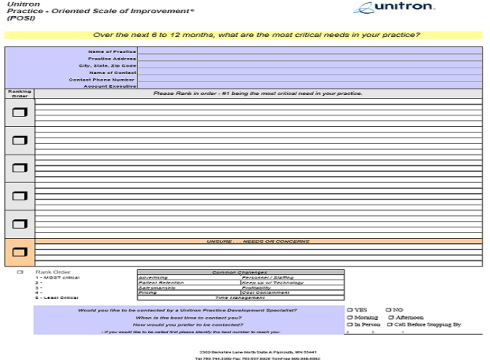
Figure 3. Practice Oriented Scale of Improvement. Click Here to View a Larger Version of Figure 3 (PDF)
Like the COSI, the POSI allows you to nominate or list up to five areas of improvement within your practice and to rank-order that list from what you think is the most important priority to the least. It enables you to sketch out your priorities, determine which one will give you the best rate of return and decide which one you want to do first.
Creating Your Action Strategy
It is one thing to know what your priorities might be. It is another thing entirely to bring it to life with an action plan. Once you have identified priorities of your practice, the next step is to then create a very simple action plan by asking four questions: What is the priority?; How do you plan to fix it?; Who is responsible for making the plan happen?; and When is the projected completion date?
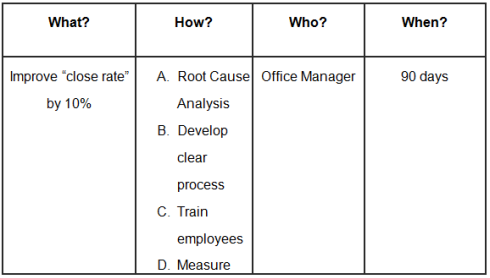
Figure 4. Graphical action plan.
Figure 4 is an example action plan for a business that wants to improve their close rate by 10%. How? You see there are four things that they have determined through brainstorming as a team that they need to do. One is something called root cause analysis, which is to figure out why the close rate is not what it should be. They're going to then develop some clear processes. They're going to train their employees, and then they're going to measure and monitor. It is a clear plan because it is documented, which pushes the accountability to the practice.
Who is the responsible person? In this example, it is the office manager. That responsible person may not be executing every aspect of the plan, but they are the designated person to monitor progress and make sure that things are getting done. When will this project be completed? In this example they specified 90 days. Another small box or area included with this graph is a place to jot down what tools and resources might be needed to meet the goal. This is important for closure of the plan once you have identified the what, how, who and when.
Big Mistake No. 6: Lack of consistent follow-up to monitor progress.
The last of the big mistakes is lack of consistent follow up to monitor progress. To paraphrase Warren Buffett, one of the wealthiest men in the world, managerial work is boring, unexciting and requires a meticulous routine. While it may not be glamorous, there is a sense of pride in progress and success, which comes from being methodical and consistent in our follow-up.
Warren Buffet talks about what effective managers do and he boils it down to three things: They communicate effectively with their staff, they expect continual improvements, and they coach, delegate and monitor progress. The actionable step for communicating effectively with your staff would be to hold weekly one on one meetings with your staff. Not only does communicating with the staff on a personal help to build trust and a better relationship, it is also a great way to monitor progress, and to ensure that staff understands the goals and how to accomplish them.
Effective managers expect continual improvements. It is not enough to just inform people on what is important to the business; you have to hold them to a higher standard. As long as they work for your practice, you expect professional growth and continual improvements in performance and contributions. The tool you use to accomplish this is a revolving door for all employees to provide feedback, including the boss. www.manager-tools.com provides excellent examples on how exactly this feedback should be delivered. They call it correcting feedback. If you do A, what happens when B follows? For example, if you chew gum when you're answering the phone, this is what happens. What is something that you could do differently? In this case, the employee would answer that they could stop chewing gum. This isn't complicated, but it is an example of how detailed-oriented you have to be as an effective manager.
Not only do you need to expect continuous improvement, but you also need to coach and mentor in a positive way by providing feedback. Identify gaps in individual performance, and help coach that employee along while monitoring their progress. If you are not particularly comfortable in this role, bring in outside resources to assist you. Help connect your employees to other organizations or agencies where they can learn more about a particular gap in their services.
One of the fundamental tenants of an effective manager is that they develop their staff. Delegate and challenge people to do different types of work. Challenging their skill set is important and helps people to grow as employees. Delegating tasks is a great way for indirect coaching and provides other responsibilities that can help employees feel needed - it is a way to "grow" the employee within their ranks.
A Pyramid of Success
The Pyramid of Success is an interesting idea based on a very successful legend in the world of collegiate basketball by the name of John Wooden. John was the long-time coach of the UCLA Bruins, winning 10 of 12 college titles in 11 seasons, and losing only 10 games total in his tenure as the Bruins' coach. He is renowned for his insights and skills in leadership, and his ideas transcend sports and are applicable to business and life in general.
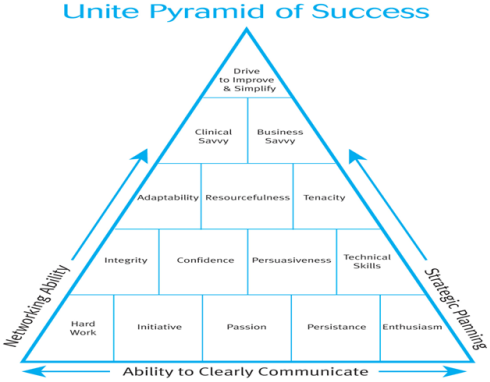
Figure 5. The Pyramid of Success, adapted by Unitron.
At Unitron, we took that idea of the Pyramid of Success and developed our own pyramid (Figure 8) for professionals in an audiology or a hearing aid dispensing practice. The foundation of our Pyramid of Success would be all the personal influences you bring to the table. Hard work, initiative, passion, persistence, enthusiasm: all extrinsic ideas and concepts that you are born with or develop at a young age. Above that, you see things that you might acquire over time, maybe early on in your career. You learn about ethics and integrity and the importance of those in your organization. You develop confidence as you practice your skills on a routine basis. You learn about the importance of persuasiveness, because in our line of work you have to be able to persuade people to want to do business with you. You have technical abilities that you learn early in your career. After gaining a few years' experience, you may be exposed to challenges over time or find that things do not always go well for you. These are business learning opportunities that come in a very competitive industry. You learn to be adaptable. You learn to persevere and develop tenacity. You learn to be resourceful and take advantage of your opportunities. All of this takes us to the next level, business and clinical savvy. Business savvy means knowing how to measure things, such as how to manage the cost of goods so that you become more profitable. Clinical savvy means providing an impeccable experience so people want to do repeat business with you. This all comes with experience.
At the pinnacle of the pyramid is the desire and drive to improve and simplify. We live in a very complex, chaotic world with an abundance of information. We have reached the top when we can simplify while driving improvement.
The three motivating forces behind this pyramid are the ability to network, strategic planning, and the ability to clearly communicate. Networking refers to interacting with your peers and other service providers who can help your business. Strategic planning is essential; it refers to knowing what you're about and how to focus and execute a plan as we've discussed today. The ability to clearly communicate serves you across all areas of your business.
These three forces are placed on the outside of the pyramid for a symbolic reason; some things do not always come from within. Some people may not have the innate ability to network, to develop business plans or to clearly communicate. You may need extra training in one or more of these areas. You might want to hire a consultant or a coach and work on polishing one or more of these skills over time.
Summary
In summary, there are three important points to take away from this seminar. First, be different in the eyes of your customer. The more memorable your business is, the more likely you are to create more word of mouth referrals to your practice. The second point is to have a clear plan, and you can use the tools presented here to guide you in the right direction. The third point goes back to the idea that management is being mundane. It's not very glamorous. It is a very routine kind of work. But as you are methodical and consistent in prioritizing and planning, great things can happen for your practice and for your patients.
References:
Dillon, H., James, A., & Ginis, J. (1997). Client Oriented Scale of Improvement (COSI) and its relationship to several other measures of benefit and satisfaction provided by hearing aids. Journal of the American Academy of Audiology, 8(1), 27-43.
Heskett, J.L., Sasser, W.E., & Schlessinger, L.A. (2003). The Value Profit Chain: Treat Employees Like Customers and Customers Like Employees. New York: Simon & Schuster.
Kaplan, R.S., & Norton, D.P. (1992). The balanced scorecard - Measures that drive performance. Harvard Business Review (January-February): 71-79.
Pine II, B.J., & Gilmore, J.H. (1999). The Experience Economy. Boston: Harvard Business Press.
Rogin, C. (2010, October 13). Top 10 reasons for hearing aid delight. AudiologyOnline, Recorded Course 14615. Retrieved November 29, 2010, from the e-Learning section on www.audiologyonline.com


